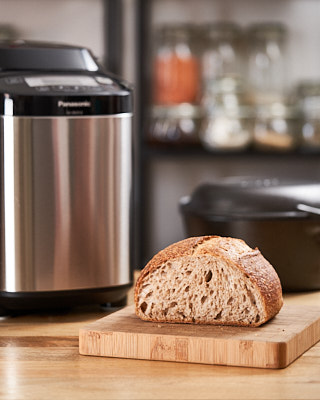This loose guide will produce two boules and assumes that the starter 1) exists and 2) is healthy and established. Currently that’s Beaker. Long live Beaker. RIP Oscar, Bert and Ernie*.
2-3 days before baking: Mix 20g of starter with 20g of strong white bread flour and 20g of water (warm-ish water if it's winter) in a small bowl. Pour into a narrow jar, mark the level with a rubber band and put the jar somewhere warm. If the starter hasn’t doubled after 12 hours (look for the tide mark), feed again and consider using some rye flour.
The night before baking: Add 100g of strong white bread flour, 100ml of water and 1 tablespoon of starter to a large bowl. Mix well, cover with a tea towel and leave somewhere warm overnight (the airing cupboard during winter). This is the levain.
Baking day: Start early and budget a minimum of 6 hours (although this is mostly hands off). The levain should look big and bubbly. If it hasn't expanded much, leave it somewhere warm for a few more hours.
Add 700ml of tepid water to the levain and stir. Add 1kg of flour (700g strong white/300g strong wholemeal) and mix until there's no dry flour left. Leave for 30 minutes (this is the autolyse stage).
Add 20g of kosher salt (add less if using non-kosher) and incorporate it into the dough using stretches and folds. Leave for 30 minutes.
Over the next 4-6 hours, tend to the dough every 30 minutes. Start with vigorous stretching then switch to coil folds to keep air in the dough. That's roughly four lots of stretching followed by four coil folds. More if time permits. I leave the dough in its bowl for the stretching and folding.
Pre-shape (with hands or a dough cutter): When the dough is ready, dampen the worktop and tip the dough onto it. Divide into two with a dough cutter. Pre-shape into balls, working tension into the surface of the dough. Set to one side for 30 minutes (15 minutes if pushed for time).
Shape: Lightly flour the worktop and flip one dough ball onto it, tension (top) side down. Gently stretch into a rough rectangle. The upper surface of the dough should be sticky. Fold into three: the bottom corners fold up into the middle and the top corners fold down over the bottom corners. It'll look like a burrito.
Rotate the dough 90 degrees anti-clockwise then stretch the top of the dough upwards and roll it downwards (think Swiss roll) until you have a rough ball. Use the dough cutter to work more tension into the surface and create a boule shape.
Put the dough ball (surface tension side down) into a lined** and floured proving basket then stitch the top of the dough for even more tension. Either:
- Leave to prove for 3-5 hours at room temperature then bake.
- Leave for 30 minutes, cover loosely with muslin cloth (thanks, Liz Earle) and place in the fridge to be baked the next day. You’re not supposed to cover the dough but I find that the bottom crust gets teeth-shatteringly tough otherwise.
Repeat for the second dough ball.
To bake: Remove the dough from the fridge. Preheat the oven to 250°C and put a 24cm cast iron pot inside (or the 6 litre Le Creuset stainless steel pan until we buy a cast iron). When ready, tip a dough ball (stitched side down) onto good quality baking paper, score (I like two parentheses-like cuts), then use the paper to lower the dough into the pot. Put the lid on, optionally slide an ice cube behind the paper for extra crust blistering, then place in the oven for 45 minutes.
The bread should be done when the timer sounds. If using the 6 litre stainless steel pan instead of cast iron, put the bread (with the baking paper) onto a baking tray and bake for another 10-12 minutes.
When the bread is ready, allow it to (mostly) cool before cutting into it. Cutting when still hot will make the crust gummy. Be patient.
* All successful starters were provided by my neighbour and master baker, Claire, who patiently answers all my questions and provides much reassurance ♥ That reminds me, don't use rye flour for your first loaf like I did. The mess it made still haunts me to this day.
** If I don't line my bannetons, the dough sticks to them even when thoroughly floured.











